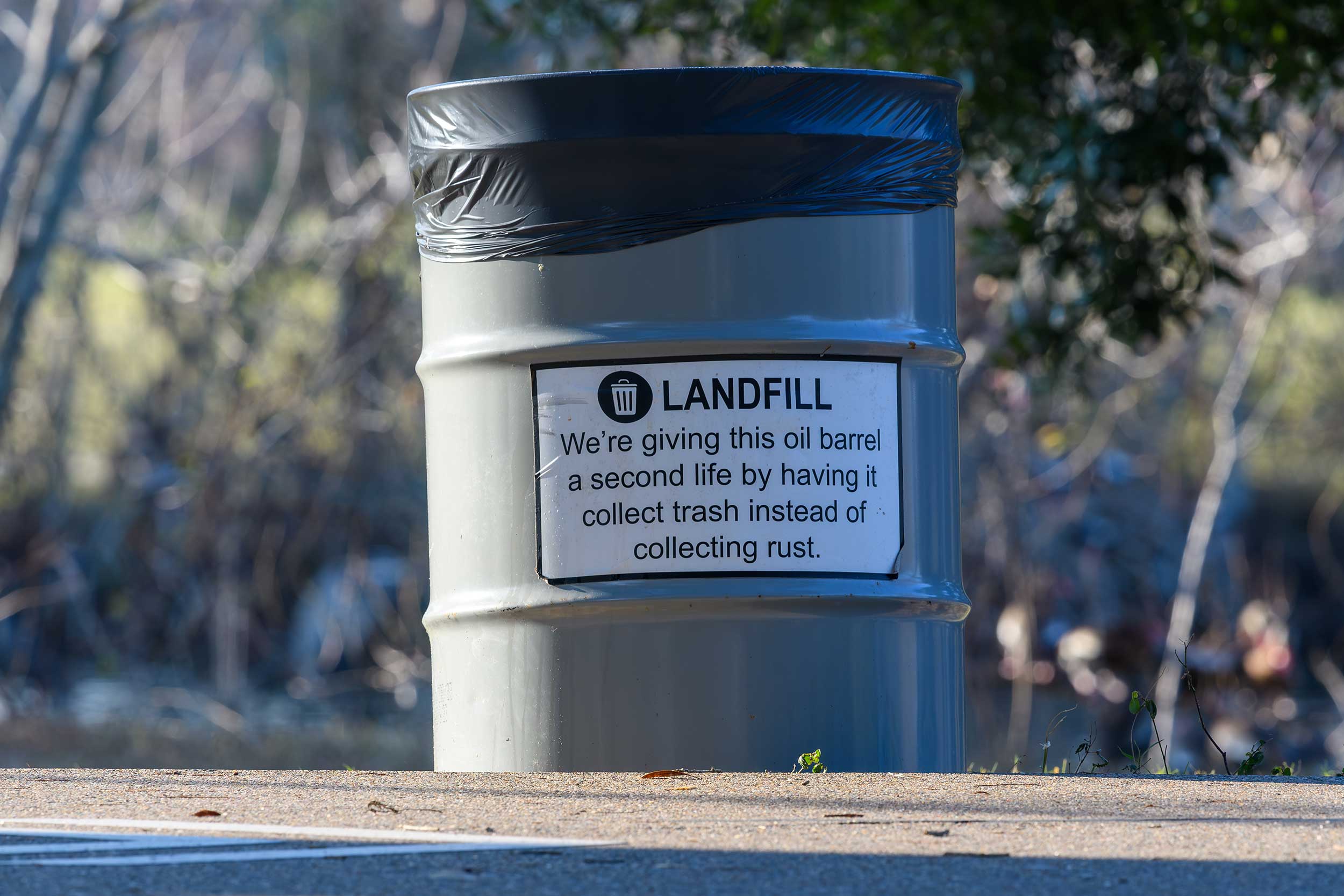Hey team, and welcome back to one5c! A couple weeks ago, I noticed a label on an airport trash can: Instead of “waste” or “garbage,” the bin was stamped “landfill.” I get a little obsessive about things like this—the wee tweaks that nudge people toward an eco-mindset. This is especially true when it comes to the words we use, because they’re a way to embed our goals in the way we move through the world every single day.
I was surprised by what I found when I started to look into what happens when we reconsider how we talk about trash. —Corinne
The right way to talk about trash
By Corinne Iozzio

Americans make a lot of garbage: close to 5 pounds per person per day, on average. Most of those discards wind up in the landfill, which is a scary place. Refuse gets piled up so high and packed in so tightly that it gets no oxygen and winds up spurting obscene amounts of methane—a greenhouse gas around 28 times as potent as carbon dioxide—as it breaks down. Municipal landfills are responsible for 14% of all methane gas in the U.S., according to the EPA.
It’s sentences like these ☝🏻 that make us want to avoid sending anything to the landfill at all costs. (Anyone else remember the influencers who collected a year’s worth of trash in a Mason jar?) But now, many of the most zealous waste-watchers have come to admit that it’s impossible to be perfect. Yet our fear of the landfill seems to have stuck. Some places—think airports, malls, schools, parks—have even taken to labeling their garbage bins “landfill” in the hope that it will spur more recycling.
Could such a simple tweak really change our behavior for the better?
Short answer
“Trash” is a better choice than “landfill.” “Garbage” or “litter” are acceptable, too.
Long answer
Labeling a receptacle “landfill” can backfire, says Mitch Hedlund, founder and executive director of Recycle Across America (RAA), a nonprofit that advocates for standardized bin labels and whose marks adorn about 10 million trash and recycling bins nationwide. Why? Because fear is a powerful motivator. “People are afraid to put things in the landfill,” she says.
Staring down the reality of a piece of garbage’s final resting place seems to spark more guilt than a comparatively ambiguous word like “trash” does. That might sound like a good thing, but, Hedlund says, RAA’s noticed that the threat of a Wall-E future can push people toward wish-cycling. A pair of case studies published in the Journal of Consumer Psychology in 2020 saw similar results.
Wish-cycling, sometimes more dryly referred to as “overinclusive recycling,” is an unfortunate side effect of being eco-minded in a consumption-heavy culture. The drive to not create trash means that people default to the blue bin when they shouldn’t—or when they’re not sure where a particular item, like a takeout container or brown paper napkin, should go.
The result of this is contamination in the recycling stream—and a lot more trash. Dirty or non-recyclable materials making their way into the flow is a top reason batches get rejected at recycling facilities. That’s not to say it’s our fault this happens; it’s a symptom of a system that Hedlund says is “designed to fail.” Clear and direct bin labeling is one salve for its shortcomings; Rhode Island, for instance, has implemented RAA’s suite of recycling and trash-can labels statewide and seen a 20% jump in overall recycling and a 20% dip in rejected recycling loads.
Best answer
Check your guilt and embrace “trash.” We have to accept that waste happens, and creating extra anguish around it can mess up what is working in our existing recycling systems—and makes what’s bad even worse. Plastic recycling, in particular, is an infamous mess, with only 5% of U.S. castaways finding a second life. But we’re really good at recycling paper (68.2%), decent at aluminum (34.9%), and okayish at glass (31.3%). Yes, the country needs more plastic-reduction laws like the one coming into effect in California in 2025. In the meantime, however: Nudging ourselves to recycle what we shouldn’t only makes more trash.
Corinne Iozzio is the Editor-in-Chief of one5c, and an award-winning science and tech editor with more than 15 years of experience. Prior to joining one5c, she was the Editor-in-Chief of Popular Science, and contributed to publications including The Atlantic, Fortune, and Scientific American.
The roundup
In the news this week
- Health insurers are weighing changes in premiums due to the risks the climate crisis and extreme weather events like wildfires pose to human health, reports The Wall Street Journal.
- New York City lawmakers are floating a ban of laundry and detergent pods and sheets. The law would apply to pre-portioned cleaners that use a type of plastic called polyvinyl alcohol, or PVA, that breaks down into microplastics and enters waterways.
- The real estate brokerage Redfin has announced that it will start including air quality ratings in its home listings. The rating will show potential homebuyers the average number of days the area has poor air quality in a year.
- According to a new U.N. report, about 1 in 5 of Earth’s migratory species are at risk of extinction. The authors stress that conservation efforts like habitat restoration, protected crossings over roads, and regulations that prevent overconsumption need to be scaled up.
- The Department of Energy will push $63 million into heat pump manufacturing. That’s in addition to the $169 million it announced last November. It’s a helpful nudge for more Americans to make the swap to the efficient systems: Heat pump water heaters, for example, are up to three times more energy efficient than their gas-powered counterparts.
